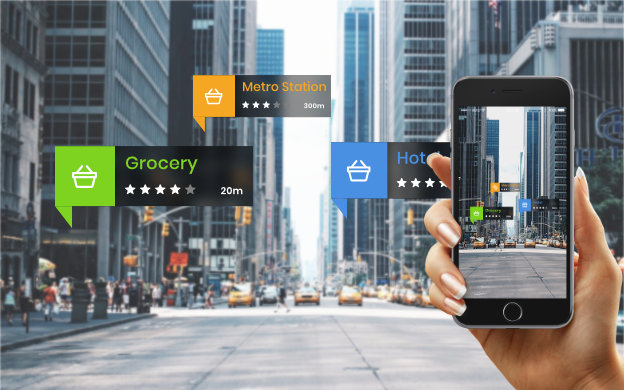5 Top-Notch Frameworks One Can Use To Develop AR Mobile Apps
Change in life is the constant; and changes in the field of technology are no different. As everything around a typical software design manager is changing, their is a need for them to keep up as well. Latest trends, being momentary, need to be followed just as they come out, and so keeping a tab on what’s new in the market, is what keeps businesses alive. It is through augmented reality - one of the more disruptive forces in sectors other than IT, that software development experts and companies at large are able to overlay digital data over objects of the real world. 
The significance of AR cannot be undermined in any case; and so, we have come with a few pointers of our own, on how certain tools can help you achieve AR in the field of mobile app development.
Vuforia A complete software design tool, which is used to develop AR mobile applications, Vuforia supports 3D and 2D recognition, target tracking, mapping, virtual buttons, that is through OpenGL, and much more. If you need a continual experience, that can be provided through a tool that supports extended monitoring, even though the target itself might be out of view, you know Vuforia is your answer. You can design any terrain in real time, given that this tool has a TerrainTM feature. So, constructing a 3-D geometric map, while you’re also detecting certain targets, such as text, or images, or just some objects - you can make use of Vuforia. In addition, while you’re using this software, you can even take advantage of apps which make use of a database, which could be located either on the local devices or on the cloud. A benefit of Vuforia is also the way it supports test app with comments and also virtual reality devices that further display the abilities of this framework.
ARToolKit When you carefully combine the software tools which are significant to AR mobile application development, you get ARToolKit. The advantage, one of many, is that you can use any platform - Windows, Mac OS X, Android, iOS, Linux, or SGI - and you will find this tool supporting each of these, seamlessly. Another important thing is, you get an open-source environment to design. So, even as every platform has its own design environment to work on, you can relax in the fact that you can make any changes to the code, and anyone can have an access to the library at all times.
LayAR A very important tool to have in your toolkit, LayAR supports the mapping of extra items on a user’s images and location. Any framework you take, you will find data related to specific social network users as well as other fields, right in there. Then there’s also the fact that the ability of any printed product depends a great deal on the functionality. So, let’s say, you want to listen to some songs you just laid eyes on, in a magazine, all you need is the help of an application based on LayAR. Almost all of the work is done on the server, and the good part is, it takes into consideration the mapping of all the additional elements that one wants to recognize.
Kudan AR Markerless tracking - that’s the term that comes to mind, as one thinks of Kudan AR. What it means is, that one can rely on natural features, like edges, corners, textures, etc. instead of fiducial marks, thanks to the functionality offered by this amazing framework. It’s also great to see how it is able to map certain extra elements on the base of an image, a user-recognized one, and location, in addition to other elements through components that are seperate, over OpenGL. The uniqueness of this tool comes from the speed that it offers, thanks to its library which single handedly assists AR mobile apps, by mapping out multi-polygon models as well as importing 3D models. Added advantages of Kudan AR, are its requirement of a lesser emory to store files, and having no limit set to how many recognized images there can be. The anual for this software has been designed to be short, and yet detailed; so, app developers rarely have a problem using the documentation that comes hand-in-hand with the framework.
Wikitude A tool that has been designed to gear towards the two largest mobile device platforms, iOS and Android, it is still possible to integrate Wikitude into certain other modules, such as a plugin for PhoneGap. The feather in its cap is the fact that it supports many software design kits, like the SLAM markerless tracing, in addition to supporting unity programming languages as well. You can even render a 2D and 3D model, based on this tool’s ability to support real objects. It’s not so difficult to digest the fact, therefore, that many users have given this tool a very strong word of recommendation.

The significance of AR cannot be undermined in any case; and so, we have come with a few pointers of our own, on how certain tools can help you achieve AR in the field of mobile app development.
Vuforia A complete software design tool, which is used to develop AR mobile applications, Vuforia supports 3D and 2D recognition, target tracking, mapping, virtual buttons, that is through OpenGL, and much more. If you need a continual experience, that can be provided through a tool that supports extended monitoring, even though the target itself might be out of view, you know Vuforia is your answer. You can design any terrain in real time, given that this tool has a TerrainTM feature. So, constructing a 3-D geometric map, while you’re also detecting certain targets, such as text, or images, or just some objects - you can make use of Vuforia. In addition, while you’re using this software, you can even take advantage of apps which make use of a database, which could be located either on the local devices or on the cloud. A benefit of Vuforia is also the way it supports test app with comments and also virtual reality devices that further display the abilities of this framework.
ARToolKit When you carefully combine the software tools which are significant to AR mobile application development, you get ARToolKit. The advantage, one of many, is that you can use any platform - Windows, Mac OS X, Android, iOS, Linux, or SGI - and you will find this tool supporting each of these, seamlessly. Another important thing is, you get an open-source environment to design. So, even as every platform has its own design environment to work on, you can relax in the fact that you can make any changes to the code, and anyone can have an access to the library at all times.
LayAR A very important tool to have in your toolkit, LayAR supports the mapping of extra items on a user’s images and location. Any framework you take, you will find data related to specific social network users as well as other fields, right in there. Then there’s also the fact that the ability of any printed product depends a great deal on the functionality. So, let’s say, you want to listen to some songs you just laid eyes on, in a magazine, all you need is the help of an application based on LayAR. Almost all of the work is done on the server, and the good part is, it takes into consideration the mapping of all the additional elements that one wants to recognize.
Kudan AR Markerless tracking - that’s the term that comes to mind, as one thinks of Kudan AR. What it means is, that one can rely on natural features, like edges, corners, textures, etc. instead of fiducial marks, thanks to the functionality offered by this amazing framework. It’s also great to see how it is able to map certain extra elements on the base of an image, a user-recognized one, and location, in addition to other elements through components that are seperate, over OpenGL. The uniqueness of this tool comes from the speed that it offers, thanks to its library which single handedly assists AR mobile apps, by mapping out multi-polygon models as well as importing 3D models. Added advantages of Kudan AR, are its requirement of a lesser emory to store files, and having no limit set to how many recognized images there can be. The anual for this software has been designed to be short, and yet detailed; so, app developers rarely have a problem using the documentation that comes hand-in-hand with the framework.
Wikitude A tool that has been designed to gear towards the two largest mobile device platforms, iOS and Android, it is still possible to integrate Wikitude into certain other modules, such as a plugin for PhoneGap. The feather in its cap is the fact that it supports many software design kits, like the SLAM markerless tracing, in addition to supporting unity programming languages as well. You can even render a 2D and 3D model, based on this tool’s ability to support real objects. It’s not so difficult to digest the fact, therefore, that many users have given this tool a very strong word of recommendation.
Pritesh


Pritesh Pethani
